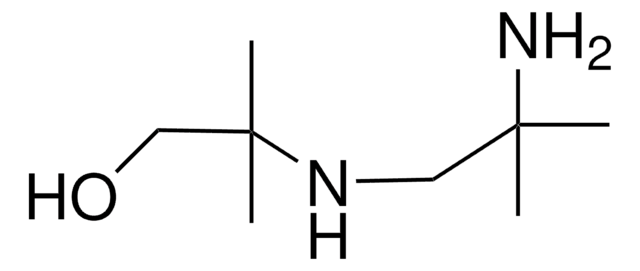Wszystkie zdjęcia(1)
Kluczowe dokumenty
CDS000144
[(2-Aminoethyl)amino]acetic acid
AldrichCPR
Zaloguj sięWyświetlanie cen organizacyjnych i kontraktowych
About This Item
Wzór empiryczny (zapis Hilla):
C4H10N2O2
Numer CAS:
Masa cząsteczkowa:
118.13
Numer MDL:
Kod UNSPSC:
12352106
Identyfikator substancji w PubChem:
Polecane produkty
Formularz
powder
ciąg SMILES
NCCNCC(O)=O
InChI
1S/C4H10N2O2/c5-1-2-6-3-4(7)8/h6H,1-3,5H2,(H,7,8)
Klucz InChI
PIINGYXNCHTJTF-UHFFFAOYSA-N
Inne uwagi
Please note that Sigma-Aldrich provides this product to early discovery researchers as part of a collection of unique chemicals. Sigma-Aldrich does not collect analytical data for this product. Buyer assumes responsibility to confirm product identity and/or purity. All sales are final.
NOTWITHSTANDING ANY CONTRARY PROVISION CONTAINED IN SIGMA-ALDRICH′S STANDARD TERMS AND CONDITIONS OF SALE OR AN AGREEMENT BETWEEN SIGMA-ALDRICH AND BUYER, SIGMA-ALDRICH SELLS THIS PRODUCT "AS-IS" AND MAKES NO REPRESENTATION OR WARRANTY WHATSOEVER WITH RESPECT TO THIS PRODUCT, INCLUDING ANY (A) WARRANTY OF MERCHANTABILITY; (B) WARRANTY OF FITNESS FOR A PARTICULAR PURPOSE; OR (C) WARRANTY AGAINST INFRINGEMENT OF INTELLECTUAL PROPERTY RIGHTS OF A THIRD PARTY; WHETHER ARISING BY LAW, COURSE OF DEALING, COURSE OF PERFORMANCE, USAGE OF TRADE OR OTHERWISE.
NOTWITHSTANDING ANY CONTRARY PROVISION CONTAINED IN SIGMA-ALDRICH′S STANDARD TERMS AND CONDITIONS OF SALE OR AN AGREEMENT BETWEEN SIGMA-ALDRICH AND BUYER, SIGMA-ALDRICH SELLS THIS PRODUCT "AS-IS" AND MAKES NO REPRESENTATION OR WARRANTY WHATSOEVER WITH RESPECT TO THIS PRODUCT, INCLUDING ANY (A) WARRANTY OF MERCHANTABILITY; (B) WARRANTY OF FITNESS FOR A PARTICULAR PURPOSE; OR (C) WARRANTY AGAINST INFRINGEMENT OF INTELLECTUAL PROPERTY RIGHTS OF A THIRD PARTY; WHETHER ARISING BY LAW, COURSE OF DEALING, COURSE OF PERFORMANCE, USAGE OF TRADE OR OTHERWISE.
Ta strona może zawierać tekst przetłumaczony maszynowo.
Hasło ostrzegawcze
Warning
Zwroty wskazujące rodzaj zagrożenia
Zwroty wskazujące środki ostrożności
Klasyfikacja zagrożeń
Eye Irrit. 2
Kod klasy składowania
11 - Combustible Solids
Klasa zagrożenia wodnego (WGK)
WGK 3
Temperatura zapłonu (°F)
Not applicable
Temperatura zapłonu (°C)
Not applicable
Wybierz jedną z najnowszych wersji:
Certyfikaty analizy (CoA)
Lot/Batch Number
It looks like we've run into a problem, but you can still download Certificates of Analysis from our Dokumenty section.
Proszę o kontakt, jeśli potrzebna jest pomoc Obsługa Klienta
Masz już ten produkt?
Dokumenty związane z niedawno zakupionymi produktami zostały zamieszczone w Bibliotece dokumentów.
Sandra Anne Banack et al.
Neurotoxicity research, 33(1), 184-191 (2017-05-06)
β-N-Methylamino-L-alanine (BMAA) is a non-canonical amino acid implicated as a cause for amyotrophic lateral sclerosis/parkinsonism dementia complex and potentially other neurodegenerative diseases. As interest in this molecule has increased, there has been a proliferation of methods along with a plethora
J S Metcalf et al.
Amino acids, 49(8), 1427-1439 (2017-06-18)
Chronic dietary exposure to the cyanobacterial toxin β-N-methylamino-L-alanine (BMAA) triggers neuropathology in non-human primates, providing support for the theory that BMAA causes a fatal neurodegenerative illness among the indigenous Chamorro people of Guam. However, since there are two stereoisomers of
Sung Vo Duy et al.
PloS one, 14(8), e0220698-e0220698 (2019-08-07)
The neurotoxin β-N-methylamino-L-alanine (BMAA), suspected to trigger neurodegenerative diseases, can be produced during cyanobacterial bloom events and subsequently affect ecosystems and water sources. Some of its isomers including β-amino-N-methylalanine (BAMA), N-(2-aminoethyl) glycine (AEG), and 2,4-diaminobutyric acid (DAB) may show different
Zacharias J Smith et al.
Toxins, 12(9) (2020-09-03)
Chautauqua Lake, New York, is a two-basin lake with a deeper, cooler, and less nutrient-rich Northern Basin, and a warmer, shallower, nutrient-replete Southern Basin. The lake is populated by a complex mixture of cyanobacteria, with toxigenic strains that produce microcystins
Daniel G Beach et al.
Analytical and bioanalytical chemistry, 407(28), 8397-8409 (2015-09-24)
The neurotoxin β-N-methylamino-L-alanine (BMAA) has been reported in cyanobacteria and shellfish, raising concerns about widespread human exposure. However, inconsistent results for BMAA analysis have led to controversy. Liquid chromatography-tandem mass spectrometry (LC-MS/MS) is the most appropriate method for analysis of
Nasz zespół naukowców ma doświadczenie we wszystkich obszarach badań, w tym w naukach przyrodniczych, materiałoznawstwie, syntezie chemicznej, chromatografii, analityce i wielu innych dziedzinach.
Skontaktuj się z zespołem ds. pomocy technicznej

![4-[(3-aminopropyl)amino]-4-oxobutanoic acid AldrichCPR](/deepweb/assets/sigmaaldrich/product/structures/209/799/796e70c9-d7f0-4443-ba30-e905b78e049d/640/796e70c9-d7f0-4443-ba30-e905b78e049d.png)







